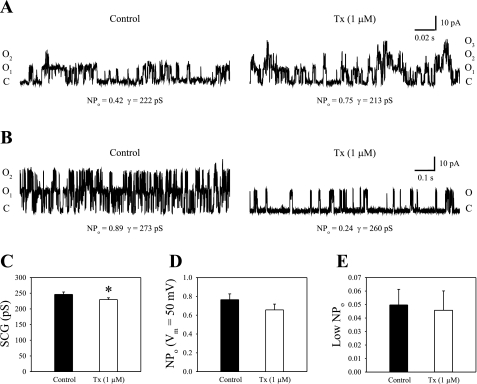Fig. 2.
Overall, tamoxifen (Tx) had an insignificant effect on BK channel open probability while reducing single-channel conductance. A and B: single-channel current traces are shown for two outside-out patches excised from two hair cells positioned at different locations in the epithelium [0.10 mm DAE (A) and 1.40 mm DAE (B)]. The holding voltage was 50 mV in each case. The patches were locally perfused with control saline (left) and 1 μM Tx (right). C, closed state; O1…On, open levels 1 to n, respectively. In A, tamoxifen increased BK channel open probability in the patch. In B, tamoxifen decreased BK channel gating. C: the averaged single-channel conductances (SCG) are shown in control condition and 1 μM Tx. Tamoxifen reduced single-channel conductance from 246 ± 8 pS in control to 232 ± 6 pS in 1 μM Tx (n = 19). *P < 0.05. D: NPo at 50 mV is shown in control saline and 1 μM Tx. Open probability was 0.77 ± 0.06 in the control condition and 0.66 ± 0.06 in the presence of Tx (n = 19). The difference was statistically insignificant (P > 0.05, paired Student's t-test). E: the effect of Tx was also examined while BK channels were held at low NPo. Open probability was 0.049 ± 0.012 in the control condition and 0.046 ± 0.014 in the presence of tamoxifen (P > 0.05, paired Student's t-test, n = 6). Thus, tamoxifen had no effect on BK channel gating when the activity level was initially high or low.

